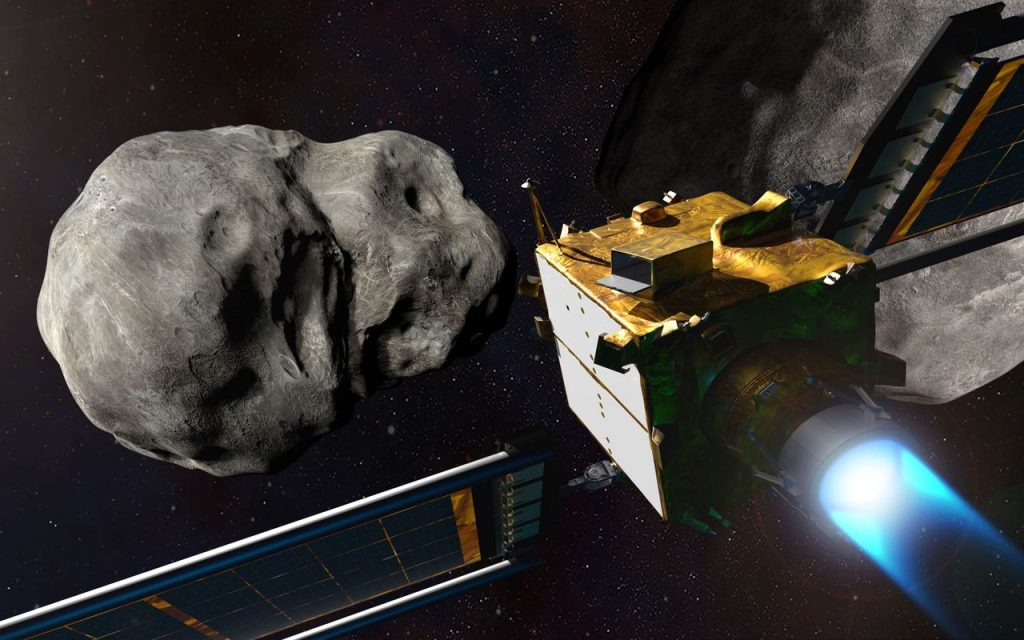Deflecting a space object seems no longer an element of science fiction – courtesy of NASA’s DART mission, a part of the Planetary Defense strategy established in 2016. The mission launched on SpaceX Falcon 9 rocket from Vanderberg Space Force Base in California on Wednesday, Nov 24, 2021.
What is Planetary Defense?
You might have heard of the Dinosaurs and their pitiful extinction resulting from an asteroid that slammed into the Earth around 65 million years ago. Our planet has always been defenseless to such incoming space bodies.
Planetary Defense incorporates all the technologies and strategies that, in the initial stages, can detect and alert any possible asteroid or comet hitting the Earth and, later, can either prevent them from causing life-threatening scenarios or mitigate the effects.

What is the DART mission?
DART is an abbreviation for Double Asteroid Redirection Test. It is a spacecraft designed to target a binary asteroid system called Didymos. The Didymos system is not a threat to our planet; its orbit around the Sun is such that it will never coincide with that of the Earth. Hence it acts as a perfect testing ground to assess whether a deliberately launched spacecraft to crash into an asteroid can effectively deflect its course, should an Earth-threatening body be discovered in the future.
DART is NASA’s first mission to achieve planetary defense objectives cataloged by the Planetary Defense Coordination Office (PDCO), whose key goals lie in:
a) providing advanced detection of potentially hazardous objects (PHOs) predicted to come within 5 million miles of Earth’s orbit and a size ranging from 30 meters to 50 meters, causing significant destruction
b) tracking and classifying PHOs on their severity and potential impacts, and issuing warnings of the same
c) implementing strategies and incorporating technologies to diminish impacts
Mission in detail
The DART mission’s underlying science is based on Kinetic Impactor technology. Kinetic Impaction involves sending spacecraft moving at high speeds to directly collide with the approaching Near-Earth Objects (NEOs). The Didymos binary asteroid system is composed of a larger asteroid named Didymos-A that is 780 meters in diameter and is orbited by a smaller one named Didymos-B or Dimorphos, which is 160 meters in diameter and takes around 12 hours to complete one revolution around Didymos-A.
The spacecraft will impact Dimorphos at a speed of 6 km/sec and will deflect its current path by a smaller margin. The expected outcome is the orbital period of Dimorphos getting decreased by a few minutes from the initial 12 hours and its speed being reduced by a few cms/sec. It is to be noted here that even though the speed reduction is not so significant, the amount of time of such collision before an actual body hits Earth will be a key factor. That is, a small reduction in speed, much advance in time, will have a cascading effect in deflecting its path that was earlier in route to collide with Earth.

As viewed from Earth, Dimorphos passes in front of and behind its larger counterpart while orbiting, making it an eclipsing binary system. Hence, Earth-based systems can measure its orbit by measuring the regular variation in brightness of the combined Didymos system. Measuring the variation after the impact and comparing it with the earlier will provide the details in the change of Dimorphos’s orbit.
The two bodies which are relatively smaller in dimensions as compared to the vastness of space also do not have a distance between them large enough for the existing systems to guide the spacecraft specifically on the smaller one. An advanced technology, SMART NAV, built on missile guidance algorithms, will autonomously guide the spacecraft in hitting the target. The DART spacecraft also embodies NASA’s Evolutionary Xenon Thruster-Commercial (NEXT-C) ion propulsion engine which is 3 times more powerful than the current ion engines.
The DART spacecraft is scheduled to impact Dimorphos around September/October of 2022 when the Didymos system will be closest to Earth – roughly 11 million kilometers. This will enable Earth-based telescopes to have better calculations of the impact and its effects thereafter.

The Road Ahead
While it gives a certain sense of relief that no known asteroid larger than 140 meters in size has a significant chance to hit us and have a catastrophic impact in the next 100 years, it places more onus on us to keep looking for them as only 40 percent of them have been found as of October 2021. The others might be lurking in the darkness of space and who knows when we get a surprise like the one that broke up over the city of Chelyabinsk, Russia in 2013.
This mission and the future ones give us hope to evade any possible encounter that possesses the power of wiping us off from the history of existence. Keep looking up and support the cause of Planetary Defender!!

